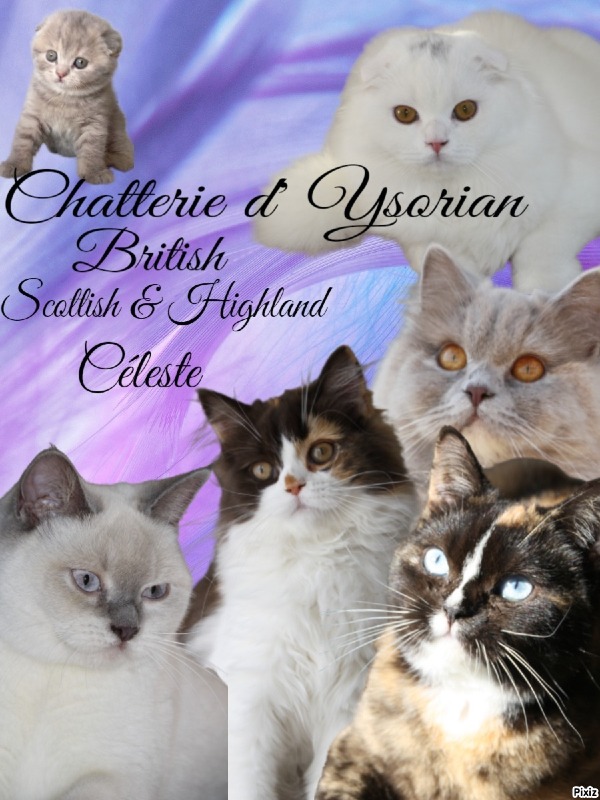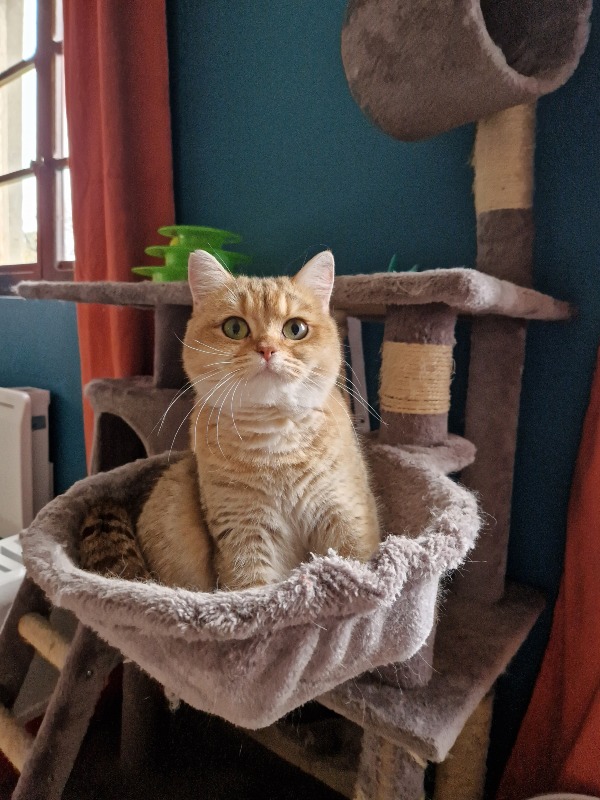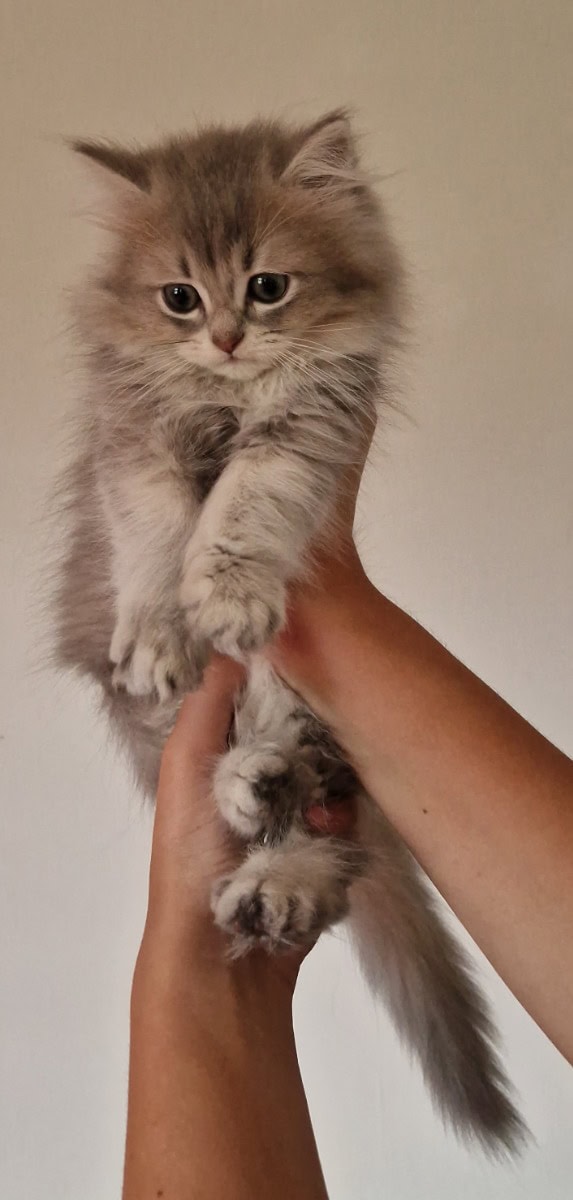British longhair
Autres noms : Cat british long hair, Cat long hair british, Highland straight, Lowlander
Discover the British Longhair, a cat with a lush coat and a gentle personality. Valued for its affectionate temperament and majestic beauty, it is the ideal companion for families and cat lovers alike.
Awareness of acquiring an animal
Adoption and breeding of cats should always be guided by a sincere attachment to the animal and an understanding of its specific needs. Whether for leisure or passion, it is essential to provide a safe, enriching, and suitable environment. Avoid any impulsive acquisition that could harm their well-being. Cats require attention, regular healthcare, and a secure space. Commit to providing them with a quality life by being a conscientious and informed owner or breeder.
To learn more about animal welfare, we invite you to consult our FAQ by clicking the button below:
Origins and history
The British Longhair is a cat breed that originates from the British Isles. Its history begins with the breeding of short-haired cats in the country, notably from local varieties that were influenced by crossbreeding with cats imported from the East in the 19th century. The need for robust cats adapted to the British climate led to a rigorous selection of certain physical characteristics.
In the 1960s, a growing interest in long-haired cats resulted in the selection of long-haired specimens from the breed. Breeders began to cross Persian cats with British Shorthairs to develop these luxurious coat traits without compromising the typical characteristics of the British.
Today, the British Longhair is valued for its dense and silky fur, as well as its calm and affectionate temperament. Its popularity has significantly increased, particularly due to its majestic appearance and sociable character, making it especially cherished as a pet.
Physical characteristics
The British Longhair is a cat breed easily recognizable thanks to its distinctive appearance and luxurious coat. Its body is robust and well-muscled, offering a balanced and harmonious silhouette. The legs are short and solid, with broad paws that give it a stable and majestic gait. The tail is of medium length, often bushy, adding to its overall look.
The head of the British Longhair is wide and rounded, with full cheeks and a strong jaw. The eyes are round and expressive, often copper or golden in color, contributing to its undeniable charm. Its ears are of medium size, slightly rounded at the tips, and well-spaced on the skull. This feature, combined with its short muzzle and broad nose, gives it a friendly and adorable appearance.
The coat of the British Longhair is dense and semi-long, with a soft and silky texture. This very thick double coat requires regular grooming to prevent tangles. The variety of colors and patterns in this breed is impressive, ranging from solid shades to tabby patterns, making it an attractive choice for cat lovers. This combination of physical traits makes it a breed that is both elegant and playful.
Character
The British Longhair is a cat breed appreciated for its unique personality traits. It is an affectionate companion that loves to be in contact with its humans. Their gentle and patient nature makes them ideal friends for families, including those with children. They are sociable but also know how to appreciate their independence, allowing them to adapt easily to different environments.
Intelligent and curious, these cats are always in search of new discoveries. They enjoy exploring their surroundings and interacting with the objects around them. However, their curiosity is tempered by a thoughtful attitude; they do not rush into situations without assessing the risks. This makes them relatively calm animals that often prefer to observe before acting.
Another notable trait is their loyalty. They form strong bonds with their owners and often seek to spend time in their company. Although they are not always clingy, they enjoy sitting close to their human friends, offering a perfect blend of affection and autonomy. These characteristics make the British Longhair an ideal choice for cat lovers seeking a companion that is both gentle and intelligent.
Life expectancy
The life expectancy of a British Longhair cat generally ranges between 12 and 15 years. However, some individuals may live beyond this range, reaching up to 20 years with proper care. Several factors influence this longevity, including genetics, diet, environment, and healthcare.
Cats of this breed tend to be robust, which contributes to their overall good health. Their dense, long coat requires regular brushing to avoid tangles and skin issues. Good hygiene is essential to prevent common diseases that could affect their life expectancy.
Furthermore, regular visits to the veterinarian allow for the early detection and treatment of potential health problems. A balanced diet and appropriate physical activities are also crucial for maintaining their well-being. By providing a safe and enriching living environment, owners can promote a long and healthy life for their feline companion.
Exercise and activity needs
British Longhair cats, although known for their thick and silky coats, have specific exercise and activity needs. While they are generally calmer than some other breeds, it is crucial to provide them with enough stimulation to maintain their physical and mental health.
First of all, a minimum of daily playtime is recommended. Owners should dedicate at least 30 minutes each day to interactive activities. This can include playing with feather wands, lasers, or balls, encouraging the cat to run and jump. These play sessions stimulate their hunting instinct while strengthening the bond with their owner.
Next, a variety of toys and play structures is beneficial. Cat trees, scratching posts, and elevated spaces encourage exploration and climbing, which are natural behaviors for this breed. It is important to create an enriching environment where the cat can move freely and thrive.
Finally, socialization is a key factor. Introducing the cat to other animals or varied environments contributes to its overall well-being. This not only helps reduce stress but also fosters curiosity and self-confidence. By meeting these exercise and activity needs, owners ensure a healthy and fulfilling life for their four-legged companion.
Recommended diet
The diet of a British Longhair cat must be carefully tailored to its specific nutritional needs. This breed is characterized by a robust build and a tendency to gain weight. Therefore, it is essential to provide a balanced diet that meets its energy requirements while avoiding excess calories.
Meals should contain a sufficient amount of high-quality protein, primarily sourced from meats. Proteins are essential for maintaining muscle mass and the proper functioning of organs. In addition to protein, it is important to ensure an adequate intake of essential fatty acids, such as omega-3 and omega-6, which contribute to the health of the coat and skin.
Hydration is another crucial aspect of the diet. It is recommended to provide your cat with wet food or to ensure that it drinks enough water. This helps to prevent urinary issues that are common in this breed.
Lastly, treats and dietary supplements should be given in moderation. A good diet is essential for ensuring the health and longevity of this charming and affectionate breed.
Training and obedience
Training and educating British Longhair cats require a gentle and patient approach. This breed is generally known for its calm and friendly temperament, but each individual has its own personality. Starting training at a young age is recommended, as it facilitates the learning of desired behaviors and establishes a bond of trust with the animal.
Socialization is essential. Exposing the cat to various environments, people, and other animals helps to make it balanced and comfortable in different situations. Positive interactions, along with rewards, strengthen the animal's confidence and open-mindedness.
When it comes to training, it is crucial to prioritize reward-based techniques. Using treats or verbal praise to encourage appropriate behaviors will promote effective learning. Avoid punishments, as this can create stress and harm the relationship with the cat.
Finally, mental stimulation is important for this breed. Provide interactive games and a variety of toys to prevent boredom and encourage healthy development. An enriching environment will help channel the animal's energy while enhancing its social and cognitive skills.
Behavior with children
The British Longhair is a cat breed renowned for its gentle and affectionate temperament. This pleasant nature makes it an ideal companion for families with children. Cats of this breed are generally kind and patient, allowing them to easily adapt to a lively family environment.
Their behavior is often characterized by a calm curiosity. They enjoy interacting with children without being overly intrusive. This enables them to coexist harmoniously with younger ones who may be a bit boisterous. British Longhairs tend to play gently, which fosters moments of sharing and bonding.
However, it is important to supervise interactions between these cats and children, especially when they are young. Children need to learn to respect the animal's personal space. A gentle and respectful approach is key to ensuring a harmonious relationship.
Finally, socialization from a young age greatly contributes to the positive behavior development of these cats. By providing them with a stable and loving environment, they will become loyal and well-balanced companions within the family.
Compatibility with Other Animals
British Longhair cats are generally known for their calm and friendly temperament, which contributes to their good compatibility with other pets. Their sociable nature often makes them open to the idea of cohabitating with dogs, cats of other breeds, and even other small animals such as rodents. However, it is essential to take into account the individual character of each animal during the introduction.
For harmonious coexistence, it is recommended to introduce the British Longhair to other animals from a young age. Early socialization can facilitate adaptation and reduce territorial behaviors. Young cats are generally more flexible and learn more easily to interact positively with other species.
It is also important to monitor the interactions between the animals at the beginning of their cohabitation. Even though British Longhairs are often friendly, moments of stress or distrust can occur, especially in the presence of more dominant animals. Creating a safe space for each pet, with separate resting areas and distinct food resources, can help minimize conflicts.
Finally, the personality of the other animal plays a crucial role. Calm-tempered dogs and other sociable cats often get along without any issues. In contrast, overly playful dogs or timid pets may require special attention during the introduction. Overall, with a patient and attentive approach, the British Longhair can make an excellent companion in a multi-pet household.
Grooming needs
The British Longhair is a cat breed appreciated for its lush coat and docile temperament. However, its grooming and maintenance needs are essential to maintain its health and appearance.
First of all, the dense, semi-long fur requires regular brushing, ideally two to three times a week. This helps remove dead hair and prevents the formation of knots and mats in the coat. During shedding periods, which typically occur in spring and autumn, it may be necessary to increase the frequency of brushing to manage hair loss.
Additionally, it is important to monitor ear and eye hygiene. British Longhairs can suffer from wax or tear accumulation, which requires occasional cleaning with a soft, damp cloth. Their claws should also be trimmed regularly to prevent them from becoming too long.
Finally, a good diet and adequate hydration are crucial for the overall health of these felines. Sufficient water intake and quality food will contribute to the health of their coat and their general well-being. By adhering to these care guidelines, owners can ensure a happy and healthy life for their four-legged companions.
Health
The health of British Longhair cats is a crucial aspect to ensure their well-being and longevity. Like many other breeds, this variety can be prone to certain genetic predispositions. Common health issues include hypertrophic cardiomyopathy, a heart disease that can affect cats of all breeds but is more prevalent in this breed. Early detection is essential for effectively managing this condition.
Additionally, dental problems are also common. Poor oral hygiene can lead to periodontal disease, highlighting the importance of regular tooth brushing and frequent veterinary check-ups to prevent infections.
It is also important to pay special attention to weight management. Due to their dense coat and generally calm temperament, these cats can easily gain weight, exposing them to problems such as diabetes and joint disorders. A balanced diet and regular exercise are therefore essential to maintain their physical health and prevent obesity.
Environment and habitat
The British Longhair is a cat breed renowned for its dense and silky coat. It is essential to create an environment conducive to its well-being, promoting tranquility and comfort. This breed thrives in calm habitats where it can both play and rest. A secure indoor space is preferable, as it protects against external dangers, such as cars and predators.
British Longhairs enjoy elevated areas where they can observe their surroundings. Cat trees and suitable shelves can stimulate their natural curiosity. They also appreciate having comfortable beds where they can retreat. In terms of temperature, this breed adapts well to different climates, but it prefers a temperate environment without extreme fluctuations that could harm its health.
Socialization is crucial. These cats get along well with children and other animals, which encourages a harmonious habitat. Environmental enrichment, with interactive toys and play sessions, is vital for maintaining their physical and mental stimulation. In summary, to ensure the well-being of a British Longhair, it is essential to combine safety, comfort, and social interaction in its habitat.
Name ideas
Choosing a name for a cat, especially for a breed as charismatic as the British Longhair, is an important step that reflects its personality and characteristics. Here are some tips for choosing the right name.
First, opt for a name that is easy to pronounce and understand for your pet. Cats respond better to high-pitched and distinctive sounds. Next, consider the appearance and temperament of your British Longhair. Its long, silky fur and gentle nature can inspire names that evoke beauty and nobility.
Finally, it can be interesting to choose a name that has personal significance for you, which will strengthen the bond between you and your companion.
Here is a list of suggestions: Theodore, Mistral, Emerald, Stardust, Biscuit, Moon, Velvet, Sapphire, Mirabelle, Zephyr, Cuddle, Frost, Opaline, Fluff, and Violet. These names should capture the essence and charm of this unique breed.
Average purchase price
The purchase price of a British Longhair cat can vary considerably depending on several factors. Generally, prices for a kitten from a breeder can range from 800 to 2000 euros. Price variations mainly depend on the breeder's reputation, the lineage, the coat color, and the specific characteristics of the animal.
Quality breeders who adhere to health and welfare standards may charge higher fees due to the care provided to their animals and the health testing performed. A kitten from recognized lines with championship backgrounds will often be more expensive due to its genetics.
On the other hand, prices can also fluctuate depending on the geographic region. In large cities, it is common to find higher prices due to increased demand. Shelters or animal protection organizations may offer lower adoption fees, generally around 150 to 300 euros, but these animals may not be specifically purebred.
Caring for an animal also requires additional investments: food, veterinary care, and various treatments, which need to be considered in the overall budget. In summary, while acquiring a British Longhair cat can represent a significant initial cost, it is essential to consider the long-term commitments related to its well-being.
Expenses
When deciding to welcome an animal of the British Longhair breed, it is essential to consider the monthly expenses that come with it. On average, you should budget between 70 and 150 euros per month to ensure the well-being of this animal.
First of all, food represents a significant portion of the expenses. Cats of this breed require high-quality nutrition to maintain their health and coat. Approximately 30 to 50 euros per month should be allocated for purchasing kibble or wet food, depending on the chosen brands and the specific needs of the animal.
Next, it is essential to consider health-related costs such as vaccinations, deworming, and veterinary check-ups. Although it is wiser to spread these costs over the year, it is reasonable to include about 20 to 30 euros per month in the budget.
Additionally, it is advisable to plan for expenses related to accessories and hygiene, including litter, toys, and grooming. This can add around 20 to 40 euros more each month.
Finally, it is important to account for any unexpected expenses, such as emergency veterinary fees, which may arise and should be anticipated. In summary, owning an animal of this breed requires a significant financial commitment, but it is also an investment in the happiness and health of your companion.
Destination and usage
The British Longhair is above all a highly appreciated pet due to its friendly temperament and beauty. This breed is characterized by its long, silky coat, which requires regular grooming. Because of its gentle and affectionate nature, the British Longhair easily integrates into a family home. It is very attached to its owners and often shows great affection, making it an excellent companion for both children and adults.
Owners often choose this breed for its sociability. British Longhair cats are known for their calmness and balanced temperament. They generally get along well with other pets, making them ideal for multi-pet households. This allows for a harmonious and pleasant cohabitation, promoting a relaxed environment.
This cat adapts well to both apartment living and homes with gardens. Although they enjoy spaces to play and explore, they are also happy to lounge on a couch. Their relaxed nature makes them perfect animals for those seeking a tranquil companion. Thus, the British Longhair has become a preferred choice for many families and cat lovers around the world.
Legislation and regulation
The legislation and regulation regarding the breeding and ownership of cats differ significantly from one country to another. In many European countries, there are strict animal welfare laws aimed at ensuring that animals are bred and kept in proper conditions. These laws may include requirements concerning living spaces, health, and nutrition, applicable to all cat breeds, including long-haired specimens.
In North America, regulations vary widely between the United States and Canada. In some areas, breeding standards are in place to ensure that cats are healthy and well-treated. Animal control organizations may also intervene to ensure that breeding conditions comply with animal welfare standards.
In other parts of the world, such as Asia or Africa, legislation may be less developed, although initiatives are beginning to emerge to protect domestic animals. In these regions, it is crucial to raise public awareness about the importance of animal welfare and responsible breeding practices.
In summary, laws and regulations concerning issues related to cats vary greatly, reflecting cultural differences and levels of education regarding animal welfare on a global scale.
Official recognition
The official recognition of the British Longhair cat breed varies from country to country, reflecting specific breeding standards and grooming criteria. In many European countries, this breed is well-established and recognized by major feline associations. These organizations stipulate breed standards, including physical characteristics such as long fur, round eyes, and a robust build.
In North America, the situation is different. Several cat associations do not yet recognize this breed as a distinct entity. This is partly due to the growing popularity of short-haired breeds, which has led to uneven development of interest in long-haired varieties. In Asian countries, recognition may be more recent, but many regulations have been put in place to promote responsible breeding.
Ultimately, recognition often depends on the evolution of consumer preferences and the efforts of breeders to promote the distinctive characteristics of this breed. Enthusiasts and breeders continue to advocate for their inclusion in regional standards, which could influence their status in the future.
Pedigrees
To obtain a pedigree for the British Longhair breed, several recognized organizations and breed clubs can be consulted. Among them, the International Cat Federation (FIFe) is one of the key associations formed by breeders that promotes breed standards. As an international organization, it recognizes and unites various clubs in several countries, offering pedigrees for cats that meet its strict standards.
Another major player in the field is The International Cat Association (TICA). This organization encourages proper breeding practices and issues pedigrees while ensuring that cats are bred in conditions conducive to animal welfare. It also provides the opportunity for registration in exhibitions, which can further enhance the reputation of a British Longhair breeding program.
In addition, the French Federation of Cat Associations (FFAF) is a national club that represents several breeds, including the British Longhair. The FFAF collaborates with breeders to ensure compliance with breed standards and grants pedigrees to fully compliant cats. These organizations ensure monitoring and control of bloodlines, thus guaranteeing the quality and traceability of the bred cats.
Prohibitions
The British Longhair cat breed is appreciated for its calm temperament and luxurious coat. However, certain restrictions may vary from country to country regarding the breeding, sale, or ownership of this breed. In some European countries, for example, animal protection laws and breeding regulations may impose strict restrictions to ensure the welfare of the animals. This includes requirements concerning breeding conditions, veterinary care, and animal health.
In other regions, concerns about genetic diversity and the health of specific breeds may lead to temporary bans on breeding certain animals. These measures aim to prevent hereditary health problems often associated with specific breeds, including Longhairs, which may be affected by genetic diseases.
Finally, local regulations may also exist regarding the ownership of exotic animals or certain categories of breeds. Therefore, it is crucial for current or prospective owners to consult local and national laws related to this breed to ensure compliance with existing standards.
Breeders of British longhair
Want to see more breeders of British longhair?
Check out the page of our directory listing all breeders of British longhairClassified Ads of British longhair
Want to see more ads of British longhair?
Check out the page listing all the ads of British longhairBreed clubs of british longhair
No of british longhair breed clubs are currently registered on Preeders.
If you would like to highlight your breed club, sign up for free now and be the first to appear on this page.







